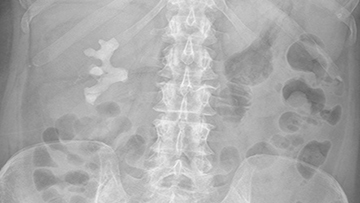
A client reports she’s about to lose a kidney due to a kidney stone. That seems . . . extreme, doesn’t it? What’s probably happening is that she has a staghorn calculus: a stone that takes up all the space in her kidney. If it’s not removed it will continue to grow, which could lead to all kinds of problems.
What is a staghorn calculus? And what accommodations do we need to make for a person who has lost an entire vital organ? These questions and more on this episode of “I Have a Client Who . . .”
Resources: 
Pocket Pathology: /abmp-pocket-pathology-app
Hill, A.J. et al. (2022) ‘Incidence of Kidney Stones in the United States: The Continuous National Health and Nutrition Examination Survey’, Journal of Urology, 207(4), pp. 851–856. Available at: https://doi.org/10.1097/JU.0000000000002331.
Staghorn Calculus: Causes, Symptoms & Treatment (no date) Cleveland Clinic. Available at: https://my.clevelandclinic.org/health/diseases/22509-staghorn-calculus (Accessed: 22 February 2023).
‘Struvite and Staghorn Calculi: Practice Essentials, History of the Procedure, Problem’ (2021a). Available at: https://emedicine.medscape.com/article/439127-overview (Accessed: 23 February 2023).
Struvite Stones (2021b) National Kidney Foundation. Available at: https://www.kidney.org/atoz/content/struvite-stone (Accessed: 23 February 2023).
Struvite Stones: Symptoms, Causes, Treatment, and Diet (no date). Available at: https://www.healthline.com/health/kidney-health/struvite-stones (Accessed: 23 February 2023).
Torricelli, F.C.M. and Monga, M. (2020) ‘Staghorn renal stones: what the urologist needs to know’, International Brazilian Journal of Urology : official journal of the Brazilian Society of Urology, 46(6), pp. 927–933. Available at: https://doi.org/10.1590/S1677-5538.IBJU.2020.99.07.


Massage Mentor Institute
In 2019, Diane Matkowski, aka the Massage Mentor, began a closed Facebook page for hosting discussions with industry leaders. These interviews gave her an idea for The Massage Mentor Institute and Jam Series workshops.
The goal was to create various continuing education classes offered in one spot. The Institute is a space for massage therapists to learn different approaches and philosophies of bodywork and business classes. It’s also home to the Shoulder, Hip, Neck, and Back Jam workshops.
We believe that no one technique works for every human being. Our goal is to help you find your path. We have selected teachers we trust, admire, and believe will help you grow as a licensed massage therapist.
Website: themassagementorinstitute.com
Facebook Group: facebook.com/themassagementor
Instagram: @massagementorinstitute
0:00:00.0 Ruth Werner: Hello, I Have A Client Who, listeners. Ruth Werner here, and I'm so excited to let you know that my library of online self-paced continuing education courses has just expanded. I now have a two hour ethics course called A Doctor's Note is Not Good Enough and What is Better? This NCBTMB approved course goes into why a doctor's permission or approval or even a prescription doesn't provide the legal or safety protection you might think it does. Then we look at how to start useful conversations with healthcare providers that will actually get us to safe and effective massage for our clients with complex conditions. Visit my website at ruthwerner.com for more information and to register for A Doctor's Note is Not Good Enough and What is Better?
[music]
0:00:52.9 Speaker 2: Introducing Back Jam, held online the first four Mondays in May, 2023 and hosted by the Massage Mentor Institute. This is the fourth event in a series of workshops focused on a single region of the body. We've gathered the following industry leaders Til Luchau, James Waslaski, Tom Myers, Diane Lee, Paul Kelly, Sue Hitzmann, Whitney Lowe, Aubrey and Alison Gowing, Allison Denny, Judith Aston, Benny Vaughn, Heath and Nicole Reed, and Ruth Werner. Sign up for the Back Jam sponsored by ABMP at the themassagementorinstitute.com.
[music]
0:01:43.0 RW: Hi, and welcome to I Have a Client Who, pathology conversations with Ruth Werner, the podcast where I will discuss your real life stories about clients with conditions that are perplexing or confusing. I'm Ruth Werner, author of A Massage Therapist Guide to Pathology, and I have spent decades studying, writing about and teaching about where massage therapy intersects with diseases and conditions that might limit our client's health. We almost always have something good to offer, even with our most challenged clients, but we need to figure out a way to do that safely, effectively, and within our scope of practice. And sometimes as we have all learned, that is harder than it looks. Hello listeners. I chose this week's story because I thought it would be a quick and easy one. [laughter] That never happens. The condition is as always more complicated and way more interesting than I had anticipated.
0:02:43.9 RW: Oh, I love my job and our story goes like this. Hi Ruth, 13 year massage therapist here. I have a client that came to me today and told me she has kidney stones big enough that she has to have her whole kidney removed next week. I declined the session today and requested that after surgery she talk to her doctor about massage. I've never had a client with one kidney and was wondering what you would do in this situation. Thanks. Wow, a kidney stone so big they have to remove the whole kidney. That sounds wild. Plus the patient is female, which is another wow because most kidney stones are way more common in males. However, I was pretty sure that I knew what the situation was in this case and here's how I replied. Oh, great story. Thanks for sharing. May I use this for a podcast, please?
0:03:39.3 RW: As a reminder to our listeners, I never share stories without permission. So I've replied, I think your client has a staghorn calculus and it has taken over her kidney. It will keep growing if they don't remove it. Fortunately, we have two times as many kidneys as we really need if her other kidney is healthy and fully functional. And that is the key question. If her other kidney is a little doubtful, maybe it is also growing a staghorn, then massage and other activities might have to be limited. So she needs to find out if she has any restrictions on exercise or other physical activities and that will give you good information about the safety of massage. I hope this helps and this is going to make a great episode. Well, now that I've gathered all this information on kidney stones and staghorn calculi, I will say that I still stand by that response, but I've learned that there have been some changes since the last time I looked at this closely, and these changes don't necessarily apply to the client in this story, but this is not such a very rare situation plus wish it is just fascinating.
0:04:44.6 RW: So listen on for more. First of all, let's do a tiny review of kidneys and kidney stones. You will remember I'm sure, that the kidneys are composed of gazillions of structures called nephrons and the nephrons interact with tiny capillary knots called glomeruli, one of my favorite words in anatomy. So these cardiovascular glomeruli are surrounded by the nephrons Bowman's capsules and fluid is pushed from the bloodstream into the nephron, and the thing that does the pushing is blood pressure. Then that fluid enters a long tangly tube. We might call it a convoluted tubule that is intertwined with more blood capillaries and that's where most of that fluid gets sucked back into the circulatory system. Anything left over which is to say water with a bunch of stuff in it, mostly things like unused hormones and a lot of metabolic wastes. All of that collects in the medial parts of the kidneys, namely the calyces, the singular for that is calyx and the renal pelvis.
0:05:56.3 RW: This large collecting site dumps all this fluid into the ureters which carry urine into the bladder, and eventually of course, that urine leaves the body via the urethra. Now occasionally the chemical environment inside those kidneys gets knocked off balance and some chemicals can precipitate out of all of that waste material and become tiny crystals. And if these block the exit route from the renal pelvis or if they irritate the ureters on the way to the bladder, well these are our typical kidney stones and they can also be called renal calculi. A calculus is the singular for that. That's another word for stone. Or if you're feeling very fancy, you can call them nephrolithiasis. Nephro for kidney, lith means a rock, and of course iasis means pathologic condition. These ordinary kidney stones have some really dependable patterns.
0:06:54.0 RW: They happen most often in males. They're often associated with dehydration. They are typically made of calcium oxalate or calcium phosphate, and they hurt like crazy. And this is because kidney swelling or excoriating the ureter sends great big messages about damage and our body reacts by taking these messages about damage very seriously. Typically, these crystals aren't huge and although they hurt while they're passing, they don't usually cause permanent damage. However, there are many other kinds of kidney stones and I'm fairly sure that the one we're talking about in today's story is something called a staghorn calculus. And that's because instead of making a group of small crystals that pass through the ureters to the bladder and out through the urethra, this type of stone has a different growth pattern. It grows within the renal pelvis and/or the calyces, and it takes up all the space in the kidney if it gets big enough.
0:07:57.8 RW: And when you look at one, it looks like, deer antlers, a staghorn. I found a spectacular x-ray of a staghorn calculus on Wikimedia that you can see in our show notes today. Or if you happen to have the seventh edition of my book, you can see a photograph of a whole kidney that has been removed because it was taken over by this enormous stone on page 487. And this is probably the procedure that our client is about to go through. What makes stag horn calculi so different from other kidney stones? Well, in the United States at least, the main issue is what the stones are made of. Staghorn calculi are not usually made of the calcium oxalate or calcium phosphate that we see with other stones. Instead, they are made mostly of a substance called Struvite, which is to say magnesium ammonium phosphate. And there's a whole story which involves bat guano about how Struvite got its name. I will spare you the details.
0:08:58.6 RW: Struvite is a crystalline material that is the result of chemical reactions, and here is a quote from the National Kidney Foundation to help explain this. They say, Struvite stones are caused by an upper urinary tract infection from bacteria, although I will say I saw in other sources that some yeasts can do this too. Back to the National Kidney Foundation, ammonia produced as a waste product by the bacteria can make the urine less acidic or more alkaline. Struvite stones form when the urine becomes more alkaline. The main chemicals in a Struvite stone include Struvite, which is magnesium ammonium phosphate, and calcium carbon appetite. These stones can grow quickly and become quite large, and this can happen with few symptoms at first or little warning. Now, I could go ahead and recite to you the chemical sequences that cause this, but you and I both know that I won't know what I'm talking about, plus is it really relevant. However, if you're interested in this, I wanna support you. So I have included the whole chemical equation in our show notes. Okay, so struvite stones are related to chronic bacterial or yeast infections of the upper urinary tract. That is to say, really centering around the kidney and the list of organisms that cause this reaction is long, long, long.
0:10:22.0 RW: So a person who gets chronic repeating upper urinary tract infections is especially at risk for struvite stones, which is to say staghorn calculi. Who gets chronic repeating UTIs? Well, here's a hint, it's the people with the short urethras. Females are at much higher risk for UTIs compared to males simply because of our construction, it's easier for pathogens to gain entry. Here's the whole list of people, especially at risk for staghorn stones according to the Cleveland Clinic, people who are assigned female at birth, people who have had many UTIs, people with a urinary tract that isn't typical or that has a different shape or drainage, people with spinal cord injuries and people with neurogenic bladder. These last two suggest that the bladder doesn't drain fully and/or the use of a catheter and that increases the risk of an upper UTI a lot. How often does this happen? It's actually hard to estimate. Struvite stones account for about 10% to 15% of all diagnosed kidney stones, but that is still a hard number to capture.
0:11:28.4 RW: The National Kidney Organization says that about 11% of all men and 8% of all women will have a kidney stone at some point. That means our chance of working with a client who has a history of some kind of kidney stone is excellent, and having a client with a Struvite stone is still pretty good. However, having a client who has lost an entire kidney to staghorn calculus, that's probably pretty rare. What does it feel like to have a staghorn calculus? Funny you should ask, because it varies a lot. Sometimes they are completely silent, but often the symptoms are connected to a flared up infection of the kidney. So signs and symptoms could include fever, flank pain, blood or pus in the urine and malaise. People may have nausea and vomiting, urinary frequency and urinary pain too. At one point I thought that the treatment for Struvite stones wasn't urgent, because we have all that extra kidney function, right? But I was very, very wrong about that because those stones can keep growing and once they get started, they grow fast. Also, any little fragment of stone left in place can be a starting point for a new large growth.
0:12:43.6 RW: It's not typical, but these can also be bilateral. They can lead to renal failure, which is dangerous and to really serious infections. In short, it's important to get these treated and to treat them thoroughly. And how do we do that? Well, the person in today's story is having her whole kidney removed, and until I started working on this episode, I thought that was standard, but it's not. There's a whole complicated protocol called percutaneous nephrolithotomy where a tube is inserted through the back into the kidney with the goal of breaking the stone into small enough pieces to be removed. This can be risky though because accidental injury to the liver on the right side or the spleen on the left side or the colon on both sides is always possible. Plus, if any little bits of stone are left in place, the whole thing can grow back. So follow-up procedures may be necessary and these are often painful and invasive. However, this does spare the affected kidney and that is a big win and this treatment is better than not treating it because research shows that the five year survival rate for people who decide not to have their stone removed is about 41%.
0:13:58.8 RW: Most of those patients die from some kidney related complication, infection, sepsis, renal failure, or kidney cancer. So let's get back to the client in today's story to review. Here's what our contributor sent. I have a client that came to me today and told me she has kidney stones big enough that she has to have her whole kidney removed next week. I declined her session today and requested that after surgery she talk to her doctor about massage. I've never had a client with one kidney and was wondering what you would do in this situation. Thanks. A person with one healthy kidney is well equipped to do most things, although they are often counseled to avoid high risk activities that might result in trauma to the second kidney. But as I told our contributor, it would be good to know that that second kidney is healthy and fully functional as is often the case. Our guiding principle here is what the client can do easily and without symptoms of kidney stress, which might include things like back pain and problems with urination.
0:15:00.0 RW: If they have to limit their physical activity, we just wanna make sure that whatever we do respects those limitations. What a great time to, with your client's permission, initiate a conversation with their urologist to make sure we're all on the same page about their physical resilience and their adaptive capacity. Hey everybody, thanks for listening to, I Have A Client Who pathology conversations with Ruth Werner. Remember, you can send me your, I Have A Client Who stories to ihaveaclientwho@abmp.com, that's ihaveaclientwho, all one word, all lowercase @abmp.com. I can't wait to see what you send me and I'll see you next time.